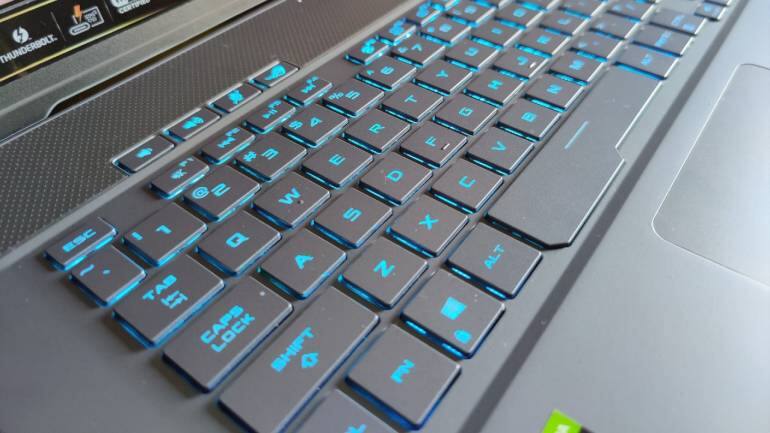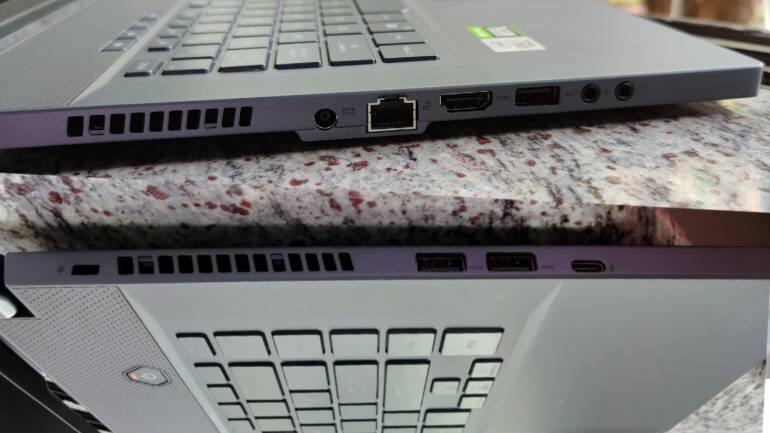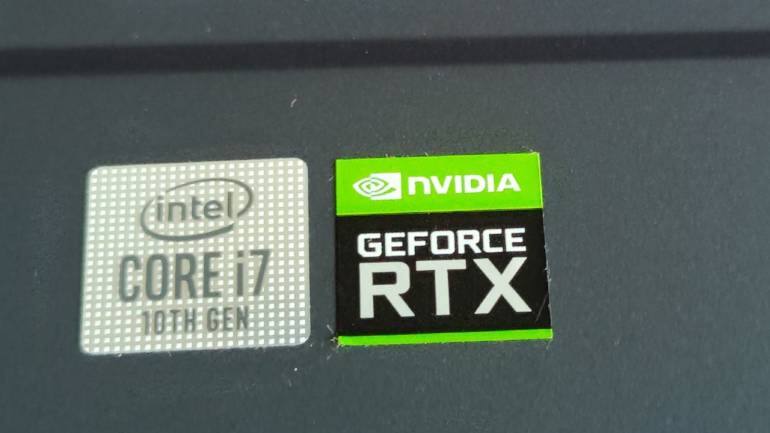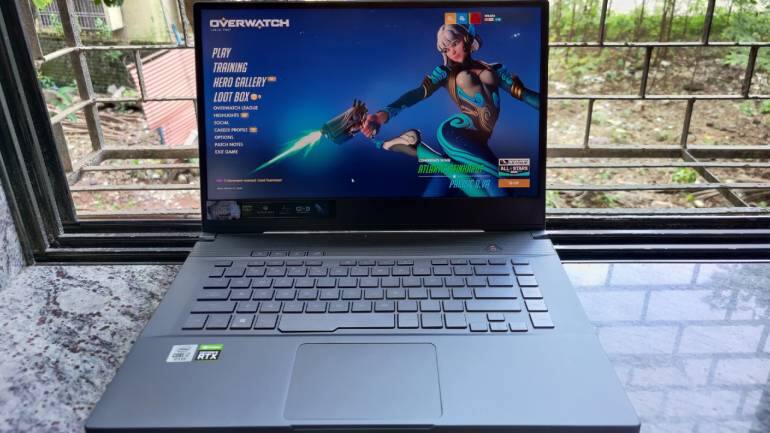



Asus recently launched the ROG Zephyrus S15, Zephyrus S17, and Zephyrus M15 in India. Both Zephyrus S models retained the traditional Zephyrus design, which shifts the keyboard to the bottom to offer better cooling in this ultra-slim form factor. Because of its unique design, the Zephyrus S models are uniquely suited for gaming enthusiast.
The Zephyrus M series, on the other hand, adopts a standard laptop design, tailored toward the 'content creator by day and hardcore gamer by night'. Our focus today is on the new ROG Zephyrus M15. The Zephyrus M15 features a starting price of Rs 1,39,990 in India, while we were told that this particular model costs Rs 1,59,990 (Presumably not inclusive of GST). The Zephyrus M15 is available in a Prism Black and Prism Grey finish.
Design
The Zephyrus M15 features an 'ordinary' design, at least going by Zephyrus standards. The M15 features a magnesium-alloy chassis and 'brushed grey' tint finish. Half of the lid has a smooth black finish, while the other half features a dotted pattern that beautifully reflects light. The Republic of Gamers logo is engraved on the bottom of the lid. Between the matte finish and the well-built chassis, the M15 really feels like a premium laptop. We weren't too bothered by the plastic lid and bottom as it didn't make the laptop feel cheap in any way.

Keyboard and Touchpad
When you open the lid, you are treated to the same smooth brushed finish, with a smooth palm rest. The M15 features a moderately sized keyboard with single-zone RGB backlighting. The keys are well spaced out with decent key travel to make the overall typing and gaming experience quite satisfactory. The touchpad area is quite sizeable with a smooth surface that made the overall experience quite good. We also found the touchpad to be quite responsive, making it ideal for regular productivity tasks.

Ports
For ports, the Zephyrus M15 features two USB 3.2 Gen 2 Type-A ports and a USB 3.2 Gen 2 Type-C input port on the right. On the left, you get a USB 3.2 Gen 2 Type-A port, an HDMI port, a microphone jack, and an audio jack. We also welcomed the addition of the RJ45 port, a noticeable absentee on the Zephyrus S17. In terms of I/O, the Zephyrus M15 is pretty well decked out.
Display
The Asus Zephyrus M15 is designed for both gamers and content creators, and nothing exemplifies this more than the two display options. You can choose between a Full HD (1080p) IPS panel with a 240Hz refresh rate and a 3ms response time or a 4K UHD IPS screen with a 60Hz refresh rate. Both panels are Pantone Validated, with the 1080p display covering 100-percent of the sRGB colour space, while the 4K option features 100-percent Adobe RGB and sRGB coverage.

Our model arrived with the 4K panel, which is more preferable for content creation. Additionally, both brightness levels as well as viewing angles, are excellent on this display. Colour accuracy is also on point here, while contrast levels are great as well. If you are only going to be gaming, we suggest going for the high refresh rate panel, given the specs of this machine can pump out high frame rates in games. However, it is always nice to have an option for professional content creators.
Performance
While the Zephyrus S series undoubtedly sits atop of the performance charts, in terms of ROG gaming laptops, our model of the Zephyrus M15 didn't fall far behind. The Zephyrus M15 we reviewed arrived with the Intel Core i7-10750H processor paired with an Nvidia RTX 2070 Max-Q graphics card. It also packs 16GB of RAM and a 1TB SSD.

The new upgrade to the 10th Gen Intel processor offers a marginal increment in performance over its 9th Gen predecessor. In Cinebench R15, the Intel processor on the Zephyrus M15 managed 1,410 points in the multi-core test. For comparison, the Zephyrus G14 with the AMD Ryzen 4800H managed a 1,846 multi-core score, which does suggest an incremental increase in performance.
It is also worth noting that the Zephyrus G14 is a much smaller laptop, and despite the G series branding, it is still almost as expensive as the M15. Additionally, single-core performance is the primary metric, at least in terms of gaming, with the Zephyrus M15 managing to come out on top with a single-core score of 194 points in Cinebench R15, as compared to the G14's 187 points. We saw similar results in Cinebench R20 tests.
From a productivity perspective, you might just get more mileage out of the ROG G14 and G15, but gaming tells a completely different story. The Zephyrus M15 came out on top in every scenario; now it is worth noting that the G14 uses an RTX 2060 card, and has a much smaller form factor, limiting cooling a bit. But on balance it does seem like Intel is still the way to go for gamers.

Let's check out some gaming performance in real-world scenarios. Before we get into the details, we tested games in 1080p resolution using the M15's Turbo mode. If you are going to buy this version of the Zephyrus M15 with the 4K panel, you will be limited to a 60Hz refresh rate, so several single-player titles can be scaled up to 4K resolution for decent results.
First off is Battlefield V, which was tested on Ultra. The Zephyrus M15 managed 105 fps, dropping to a one-percent low of 69 fps. With DLSS and ray tracing turned on, the M15 managed to hit 96 fps, dropping to a one-percent low of 62 fps. Battlefield V hit an average of 35fps in 4K resolution, which is not too shabby during campaigns. We'd prefer 1080p with ray tracing turned on.
Shadow of the Tomb Raider managed 90 fps on the highest presets, dropping to a one-percent low of 61fps. Turning up the resolution to 4K sees a major drop in frame rates, dropping to an average of 30fps.
The Asus ROG Zephyrus M15 (2020) Games like a Bowss!! @ASUS_ROG #NoobGoingPro #AsusIndia #GamingLaptops #Overwatch pic.twitter.com/OemT7ynEQa— Carlsen Martin (@Carlsen0491) October 6, 2020
The 240Hz display might be overkill, and none of the games we tested could hit those frame rates. It is worth noting that on the 4K model, you won't have to worry all that much about fps in games, on single-player titles you can run games on 4K resolution with playable frame rates. After looking at gaming performance, there is little doubt that the Intel and Nvidia combination is still going strong. While we'd love to see another AMD, Nvidia combination like on the G14 and G15, Intel still pumps out excellent performance in games.

Cooling
Before we end this conversation on performance, let's talk about cooling, which is another area that has seen significant improvements over last year's M15. First off, the CPU gets liquid metal cooling as opposed to regular thermal paste, which delivers excellent thermal performance. The CPU tends to push its limit at 93-degrees, while the GPU hits its limit at 86-degrees. However, after gaming for a while, both CPU and GPU temperatures tend to drop into the early and mid-80s depending on the title. The fans do get quite noisy, but the audio from the speakers does tend to drown it out.
Audio
Speaking of audio, the Zephyrus M15 packs downward-firing speakers. Asus claims the audio here is certified Hi-Res. Cranked up to max, the volume can get quite loud, but audio sounds best at around 80 percent. The audio quality here is average; we recommend using headphones for the best experience as the audio over the headphone jack is superb.
Battery
When it comes to battery life, the 76Whr battery performs quite well in regular MS Office tasks, which involve using Word and Excel. We got around four and a half hours of light Office use. While watching Netflix, you should get just above five-plus hours. We wouldn't recommend using the laptop on the battery while gaming or running heavy-duty applications that use both the CPU and GPU.

Overall, for a gaming laptop, battery life is pretty decent. It is worth noting that we used the laptop in Nvidia's Optimus mode and lowered screen brightness to 50-percent during our battery test. The M15 uses a 240W power brick, but USB-C charging is also supported, at up to 65W.
Verdict
The ROG Zephyrus M15 gets a lot of improvements across the board, but perhaps its biggest improvement over last year's model is the price. Last year, the 9th Gen Intel Core i7 and GTX 1660Ti model was priced at around 1.5 lakh. This year, the 10th Gen Core i7 coupled with the GTX 1660Ti costs around 1.4 lakh. And you also get better cooling and a better panel.
Overall, there is a lot to like about the Zephyrus M15; performance is pretty solid with Intel and Nvidia making a pretty strong case for gaming. Additionally, display options are also superb, with 240Hz and 4K panel options. Even the cooling has gotten a lot better. The keyboard is good for both gaming and typing, while there's plenty of I/O for your accessories. Battery life is also pretty decent by gaming laptop standards.

You won't find too many issues unless you nitpick, like the single-zone RGB lighting, lack of a card reader, and loud fans. But the Zephyrus M15 does a good job in areas that matter the most for gamers, while also bringing powerful performance at a reasonable price.
However, when you consider the 4K panel option is designed for content creators, the missing webcam is criminal. Asus could at least include one in the box, even if it is just for the 4K option. But again, most of the issues we had with this laptop were solvable without much effort. So, if you are looking for a good laptop for hardcore gaming as well as work, then the ROG Zephyrus M15 is definitely worth considering.

Discover the latest Business News, Sensex, and Nifty updates. Obtain Personal Finance insights, tax queries, and expert opinions on Moneycontrol or download the Moneycontrol App to stay updated!